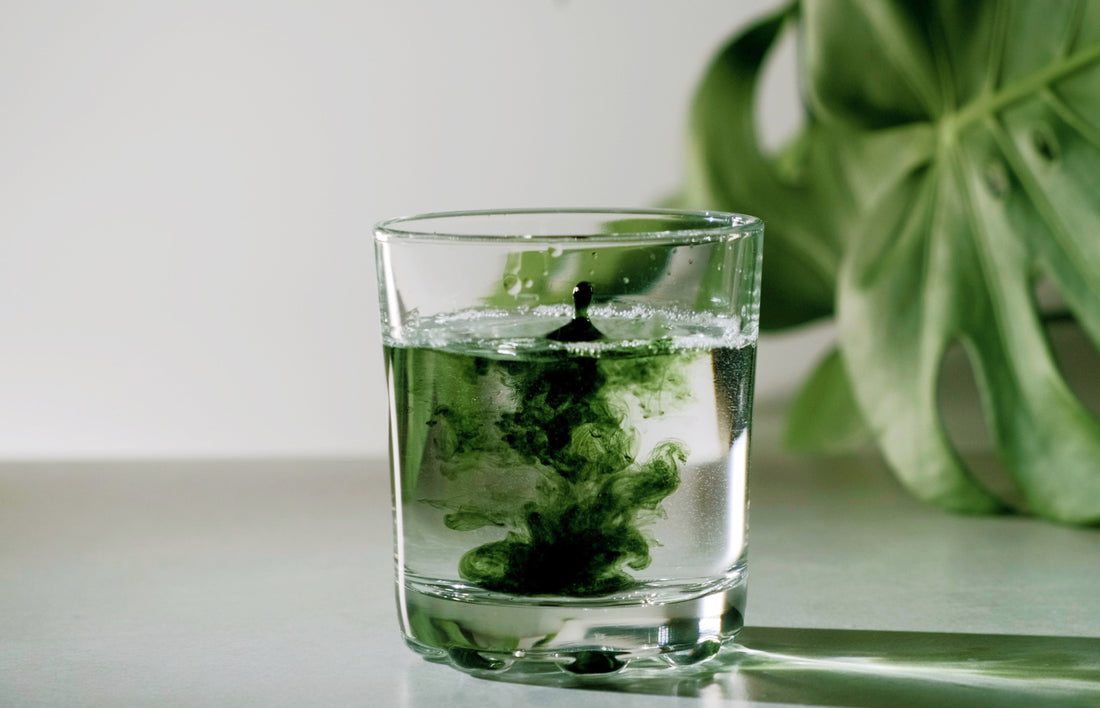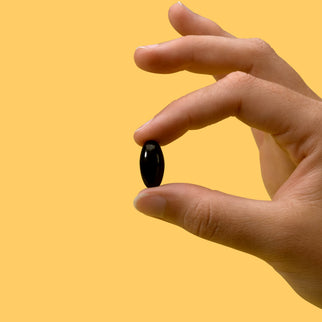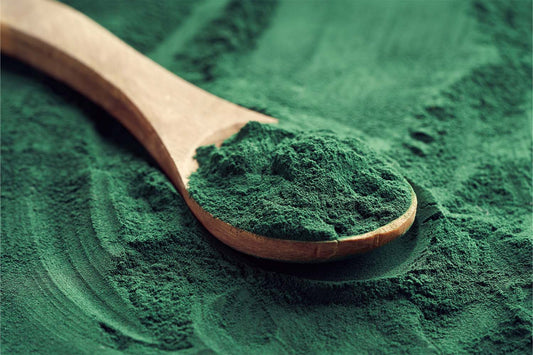If you don’t remember ninth-grade biology, we understand — but if you do, you may remember hearing the word chlorophyll. You may remember learning that it is an essential compound in plants. What you might not have heard, though, is what chlorophyll can accomplish as a health supplement.
As it turns out, this fascinating compound can offer benefits for humans as well as plants. Even after you recognize the benefits of chlorophyll, it still begs the question of how much you should take to enjoy them. Understanding how much chlorophyll you should take per day will help you safely enjoy the benefits of this powerful plant compound.
What Is Chlorophyll?
Chlorophyll is a natural compound found in plants and is responsible for the green pigment in plants, algae, and cyanobacteria. This compound is also highly involved in photosynthesis, the process in plants where sunlight is converted into energy inside the plant.
There are multiple types of chlorophyll. Chlorophyll a and b are fat-soluble, which means they do not dissolve in water, but other forms, like chlorophyllin, are water-soluble, meaning that they do. The most common forms of chlorophyll in plant foods are chlorophyll a and chlorophyll b.
Chlorophyll is usually found in the form of liquid chlorophyll and can be used as a nutritional supplement or as a topical cosmetic product.
What Are the Benefits of Chlorophyll?

Although chlorophyll serves an important function in plants, it can also have a strong role in supporting humans! Taking chlorophyll regularly can offer a few potential health benefits, given the power of this unique pigment.
Nutritional Benefits
Many chlorophyll benefits are tied to their high antioxidant properties. Antioxidants are compounds mostly found in plants. These compounds help support healthy cells during exposure to harmful molecules called free radicals, which build up in the body and cause damage to cells and tissues.
Antioxidants can provide the following potential benefits:
- Supporting the healthy aging of cells
- Supporting healthy skin
- Supporting a healthy immune system
Topical Chlorophyll Benefits
The plant compound was used frequently in the mid-20th century as an internal deodorant. Although the science around this was a little questionable, it goes to show that there is a lot to wonder about the true potential of chlorophyll and how it can be used. Some of the claims surrounding topical chlorophyll are that it might support skin health during wound healing.
Meanwhile, another way to leverage the antioxidant powers of this pigment is by using topical chlorophyll to support healthy skin. Topical chlorophyll can be found in face serums, detox masks, and face washes, in addition to many other options.
Some of the suggested benefits of using chlorophyll on your skin include potentially cleansing your pores, soothing irritation, and helping to minimize the look of fine lines.
Are There Side Effects to Chlorophyll?
Taking chlorophyll as a supplement has shown few side effects. As a supplement, chlorophyll is generally considered safe, but some people may still experience some mild side effects. It is important to pay attention to how your body responds any time you start taking any new supplement.
Some of the potential side effects of consuming chlorophyll are:
- Green stool
- Indigestion or stomach cramping
- Diarrhea
- Loose bowel movements
Topical chlorophyll is often considered safe as well, but it may cause reactions for some. If you use a product with chlorophyll and experience any redness or irritation, you should stop using it and consult a medical professional.
The biggest risk of chlorophyll is for those who may be allergic. Signs of an allergic reaction include a rash, hives, difficulty breathing, swelling, and red, watery eyes. If you think you are having an allergic reaction to chlorophyll, then seek emergency medical care.
Because more research is needed regarding the potential side effects of chlorophyll, pregnant or breastfeeding women should consult their doctors before trying chlorophyll supplements simply as a precaution. If you have any questions about whether or not taking a chlorophyll supplement is a good idea for you, you should talk to your healthcare provider about your options.
How Much Chlorophyll Should You Take Per Day?
Since chlorophyll is not required to take on a daily basis, like other vitamins, there is no set amount of chlorophyll that you should take per day. However, that doesn’t mean making it a daily supplement to a healthy diet is a bad idea.
The amount of chlorophyll you should take daily depends mostly on where you get your chlorophyll and what benefits you want.
Regardless of research, you should stick with the recommended dosage of your chlorophyll supplement. Taking too much chlorophyll may increase your risk of experiencing possible side effects. Just a little a day can go a long way toward supporting your overall health and well-being.
What Are Some Sources of Chlorophyll?

With so many great potential benefits, there are plenty of reasons to make chlorophyll a consistent part of your diet. Plus, many of the foods that contain chlorophyll come with a wide range of other vitamins and minerals, making it even more beneficial to aim for this plant compound in your diet.
Green Vegetables
Any green vegetable contains chlorophyll. After all, green vegetables are just plants that had to undergo photosynthesis to grow.
Some veggies that contain considerable amounts of chlorophyll are:
- Leafy greens like kale, spinach, romaine lettuce, and arugula
- Asparagus
- Broccoli
- Brussels sprouts
- Green beans
- Green bell peppers
- Peas
Although each of these foods contains chlorophyll, there are many other reasons to include green vegetables in your daily diet. Green vegetables are often a great source of protein, vitamin C, vitamin K, and other antioxidants. Green veggies are also a solid component of any balanced meal.
Green Fruits and Seeds
Other green plant-based foods have chlorophyll as well — not just veggies. Another great source of chlorophyll is green colored fruit. Some fruits containing chlorophyll include kiwi, green grapes, and green apples.
Green seeds like pistachios and some sunflower seeds also contain a notable amount of chlorophyll. You can include more green fruits and seeds in your diet by adding them to smoothies or yogurt or including them in salads.
Wheatgrass
Wheatgrass is a young version of the wheat plant, and its green pigment comes from chlorophyll. In addition to its chlorophyll content, wheatgrass also contains enzymes that may support healthy digestion. You can consume more wheatgrass by drinking wheatgrass juice or smoothies.
Chlorophyll Supplements
Chlorophyll supplements are another convenient way to access the potential benefits of this plant pigment. These dietary supplements are often made containing Spirulina or Chlorella. These supplements are often found in the form of a powder that you can mix with water or add to smoothies. They may also come in the form of chlorophyll drops, liquid chlorophyll, or chlorophyll water.
An advantage of taking chlorophyll supplements is that they often come with other benefits as well. For a supplement that contains chlorophyll as well as other essential nutrients, you can turn to an iwi life algae supplement. iwi life’s omega-3 Essential supplement is made from algae, so it features 500 mcg of chlorophyll on top of two essential omega-3 fatty acids — docosahexaenoic acid (DHA) and eicosapentaenoic acid (EPA).
DHA and EPA offer many potential benefits — these two omega-3 fatty acids can support heart health, support healthy joints, and help maintain cholesterol levels already within the healthy range, on top of a whole world of additional benefits.
Add Chlorophyll to Your Daily Diet
The powerful plant pigment chlorophyll has a ton of potential for supporting your health and wellness both inside and out. Consuming green vegetables and fruits whenever possible is a good idea, but iwi life can make it even easier to include more chlorophyll.
Add omega-3 fatty acids and chlorophyll as well as other valuable nutrients into your daily nutrition with an iwi life omega-3 Essential supplement. To see all the possible powers of algae-based omega-3 supplements, check out the complete family of iwi life omega-3 supplements.
Sources:
Chlorophyll | Definition, Function, & Facts | Britannica
Chlorophyll and Metallo-Chlorophyll Derivatives | Linus Pauling Institute | Oregon State University
Assessment of Chlorophyll as a Deodorant | PMC
The Role of Functional Foods in Cutaneous Anti-aging | NCBI.



















